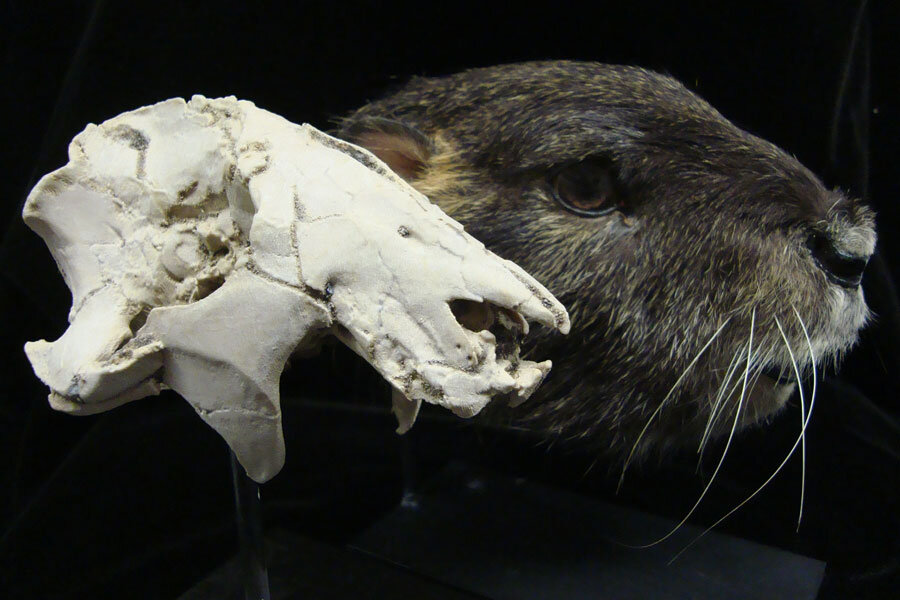'Odd' rodent-like skull could help crack mystery of when mammals emerged
Loading...
Madagascar, long known for an bizarre assortment of dinosaurs and early mammals, has yielded up another unusual creature – one that could help researchers figure out how long mammals truly have trod the Earth.
An international team of scientists has uncovered a virtually complete skull of an animal they've named Vintana sertichi. Its traits place it within a group of mammals known as Gondwanatheria.
The new specimen hails from rock formations in northwestern Madagascar that date to between 72 million and 66 million years ago, toward the end of the Cretaceous and the reign of dinosaurs. V. sertichi's skull measures just under 5 inches long, leading the team to estimate that the rodent-like animal weighed about 20 pounds – the largest mammal yet found from the Mesozoic period on what once was Gondwana and the second largest mammal from the Mesozoic worldwide.
The analysis is set to appear in Thursday's issue of the journal Nature.
The discovery is a major find, according to Brian Davis, a paleontologist who studies the early evolution mammals at the University of Louisville in Kentucky and was not a member of the team making the discovery.
It's quite rare to find mammal skulls from the age of dinosaurs, he says. “Just the fact that it is a skull, and a very complete skull at that, is a pretty big deal.”
Given the few Gondwanatheria shards found until now, “it's been really hard to stick them in some slot and relate them to other groups of mammals.”
As for the skull itself, “no paleontologist could have come close to predicting the odd mix of anatomical features that this cranium exhibits,” said David Krause, a paleontologist at Stony Brook University on New York's Long Island.
The find highlights the extraordinary diversity of mammals that existed during the Mesozoic, which spans the Triassic, Jurassic, and Cretaceous periods, researchers say.
“People often think of mammals as living mammals and that everything in the fossil record must be a precursor to living mammals, but this is not the case,” says Anne Weil, a paleontologist at Oklahoma State University in Tulsa who specializes in the early evolution of mammals.
During the Mesozoic, mammals evolved a wide range of body types – mammals that have no direct evolutionary link to modern mammals. A group of rodent-like mammals known as multituberculates, for instance, roamed Earth for some 120 million years, the longest-lasting group of mammals in Earth's history. They finally went extinct about 35 million years ago.
Sandstone formations in Madagascar have yielded some weird animals, as well as dinosaur species that had since died out on the Gondwanaland mainland, researchers note. Large crocodile-like creatures that were vegetarians, large predatory frogs, and a variety of theropod dinosaurs are among the specimens in the ancient menagerie.
Four years ago, one of Dr. Krause's graduate students returned from the field in Madagascar with blocks of sandstone and what looked like a rich harvest of fish fossils. When the blocks were subjected to CT scans, however, one of the images showed a virtually complete mammal skull.
Indeed, the word vintana means "luck" in Madagascar's national language, Dr. Krause explains. “It was pure serendipity, in that we had a chunk of sandstone that we didn't know contained the skull of a mammal.”
Without a skeleton, it's hard to figure out what V. sertichi really looked like and how that affected its movement or reflected its habitat, Dr. Weil says. For instance, modern, tree-loving lemurs have been known to tip the scales at around 20 pounds, as have ground-hugging Patagonian hares.
“With that body size and all you have is the head, you can imagine it in a number of different ecologies,” she says.
The research team notes that the large openings for the eyes, the complex inner ear, and large nerve centers for processing odors suggested that V. sertichi had a keen sense of smell, acute vision capable of dealing with low light, and an ability to hear high-frequency sounds.
Such abilities hint that, whatever its body type, it was capable of darting quickly from one place to another as well as of quick shifts in direction.
Its teeth are well adapted to grinding plant material, while its unique jaw structure suggested that the animal had powerful jaw muscles to do the chewing.
Of particular interest, however, is the where the team placed V. sertichi on the early-mammalian family tree – placement that affects estimates of when mammals first evolved. Some researchers suggest that evolution was slow, with the first mammals appearing about 175 million years ago, during the Jurassic period. Others have argued that mammals exploded onto the scene much earlier, during the Triassic, and diversified quickly. The team's analysis, based on comparisons between V. sertichi and other Mesozoic mammals, points to an early, rapid emergence and diversification of mammals.
The debate remains open, subject to relationships established by additional mammal-fossil finds from today's southern hemisphere, yesterday's Gondwanaland, Davis and Weil caution.
Still, Davis says he's confident that an emergence time and pace for the first mammals will come fairly soon.
“I think we're not too far away from that,” he says. “We're getting more and more specimens from the middle part of the Jurassic, which is getting closer to the dawn” of an early emergence and diversification.
“I'm optimistic that we'll get a cleared picture in the coming years,” he says.






